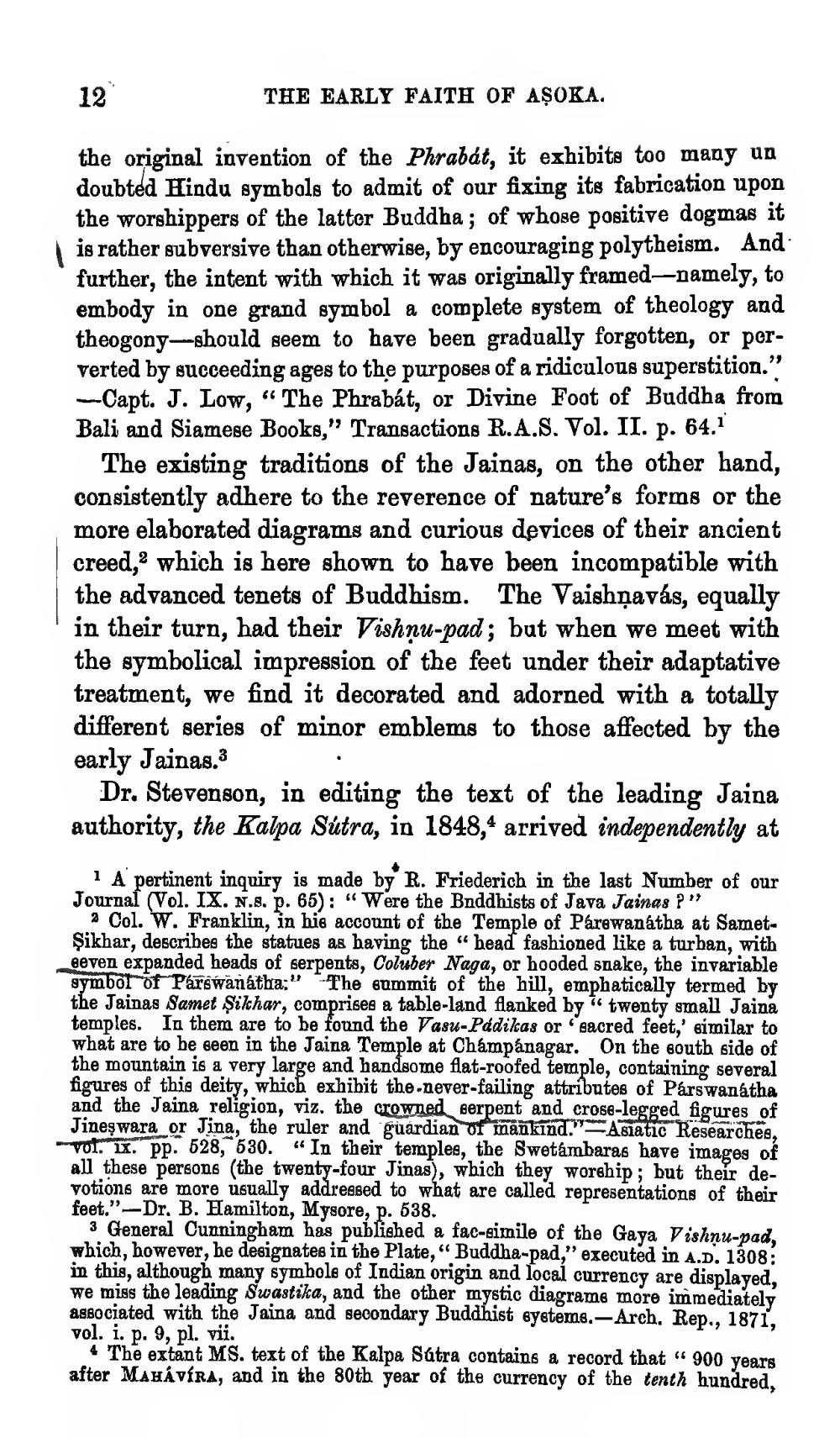________________
THE EARLY FAITH OF AŞOKA.
the original invention of the Phrabát, it exhibits too many un doubted Hindu symbols to admit of our fixing its fabrication upon the worshippers of the latter Buddha; of whose positive dogmas it is rather subversive than otherwise, by encouraging polytheism. And further, the intent with which it was originally framed-namely, to embody in one grand symbol a complete system of theology and theogony-should seem to have been gradually forgotten, or perverted by succeeding ages to the purposes of a ridiculous superstition." -Capt. J. Low, “The Phrabát, or Divine Foot of Buddha from Bali and Siamese Books," Transactions R.A.S. Vol. II. p. 64.1
The existing traditions of the Jainas, on the other hand, consistently adhere to the reverence of nature's forms or the more elaborated diagrams and curious devices of their ancient creed, which is here shown to have been incompatible with the advanced tenets of Buddhism. The Vaishňavás, equally in their turn, had their Vishnu-pad; but when we meet with the symbolical impression of the feet under their adaptative treatment, we find it decorated and adorned with a totally different series of minor emblems to those affected by the early Jainas.3
Dr. Stevenson, in editing the text of the leading Jaina authority, the Kalpa Sútra, in 1848,4 arrived independently at
1 A pertinent inquiry is made by R. Friederich in the last Number of our Journal (Vol. IX. N.8. p. 65): “ Were the Buddhists of Java Jainas ?"
2 Col. W. Franklin, in his account of the Temple of Parewanatha at SametŞikhar, describes the statues as having the “head fashioned like a turban, with eeven expanded heads of serpents, Coluber Naga, or hooded szake, the invariable symbol of Parswanatha:" The summit of the hill, emphatically termed by the Jainas Samet Sikhar, comprises a table-land flanked by twenty small Jaina temples. In them are to be found the Vasu-Pádikas or sacred feet,' similar to what are to be seen in the Jaina Temple at Champánagar. On the south side of the mountain is a very large and handsome flat-roofed temple, containing several figures of this deity, which exhibit the-never-failing attributes of Parswanatha and the Jaina religion, viz. the crowned serpent and crose-legged figures of Jineșwara or Jina, the ruler and guardian of mankind." Asiatic Researches vot. x. pp. 528, 530. "In their temples, the Swetambaras have images of all these persons (the twenty-four Jinas), which they worship; but their devotions are more usually addressed to what are called representations of their feet." - Dr. B. Hamilton, Mysore, p. 538.
3 General Cunningham has published a fac-simile of the Gaya Vishnu-pad, which, however, he designates in the Plate," Buddha-pad," executed in A.D. 1308: in this, although many symbole of Indian origin and local currency are displayed, we miss the leading Swastika, and the other mystic diagrams more immediately associated with the Jaina and secondary Buddhist systems.--Arch. Rep., 1871, vol. i. p. 9, pl. vii.
4 The extant MS. text of the Kalpa Sutra contains a record that “ 900 years after MaHÁVÍRA, and in the 80th year of the currency of the tenth hundred,




